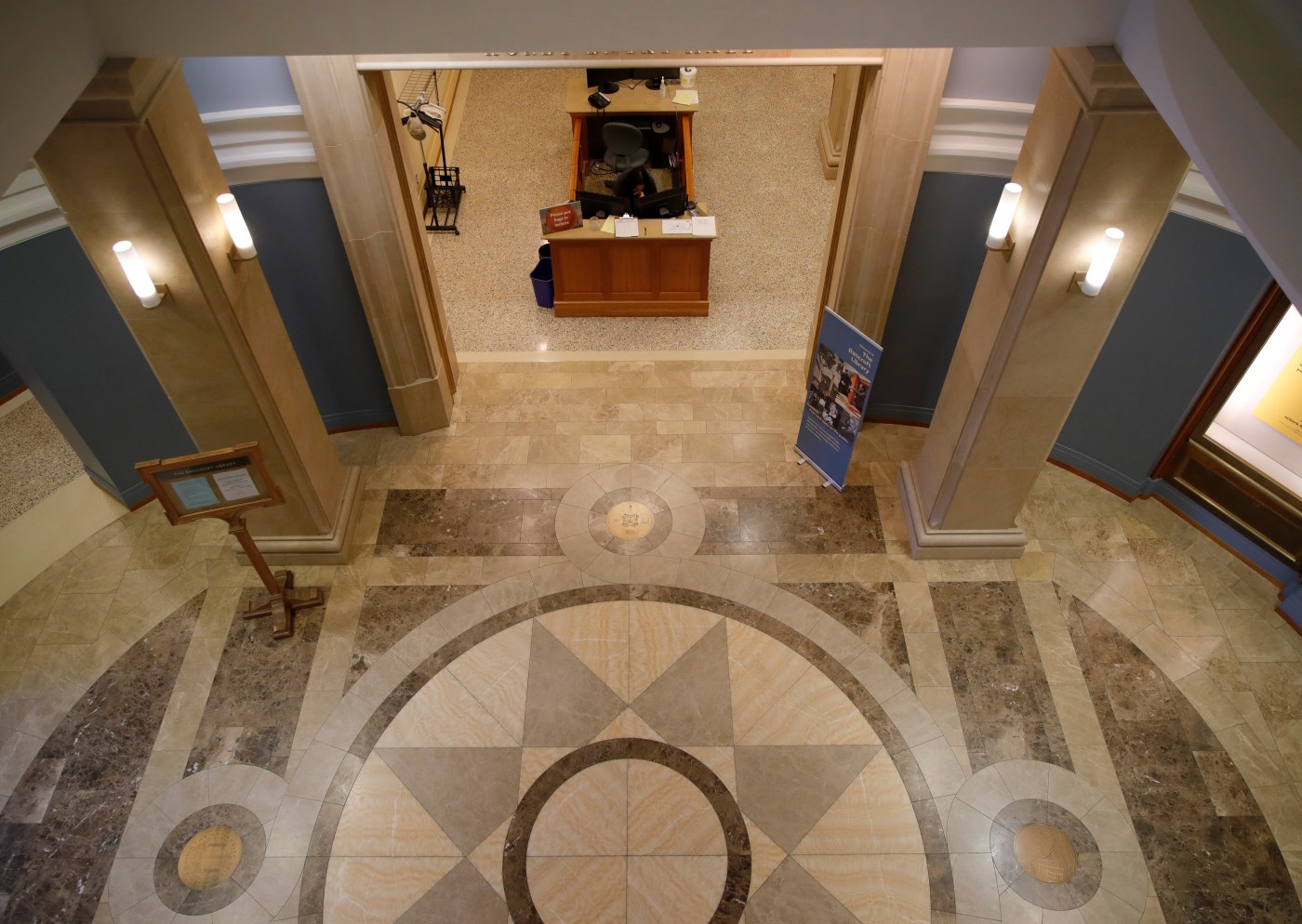As a postdoctoral scholar at UC Berkeley’s Bancroft Library, Giuliano Sidro is a serious expert on ancient writings, but his seriousness turns to silliness when he explains one of the findings in a nearly-4,000-year-old piece of papyrus.
“This right here,” he says, giggling, “is the earliest ever mention we have of weed.”
The ancient Egyptians were getting high! Well, using it for medicinal purposes, anyway.
The experts in the library’s Center for the Tebtunis Papyri agree there’s enough evidence to verify the use of shemshemet, generally regarded as cannabis, which was used to treat ingrown toenails, among other ailments. It’s all right there in writing, dated at about 1,800 BCE, the oldest known documentation indicating its use.
And while Berkeley’s scholars are still sorting through more than 30,000 fragments uncovered during a dig in the late 1800s, they’re happy to show you what they’ve found.
The folks at the Bancroft love visitors.
David Faulds, curator of rare books and literary manuscripts, flips through an antiphonary written in 1475 in Latin from Northern Italy in the special collections section of the Logan Room at the UC Berkeley Bancroft Library. (Jane Tyska/Bay Area News Group)
Related Articles
What’s the hot button issue dividing Disneyland and employees?
Former Food Network producer dishes on her new ‘Getting Sauced’ memoir
Price of camping in Angeles National Forest may jump as much as 300%
California judge dismisses gun case against rapper Boosie Badazz on constitutional grounds
Horoscopes July 16, 2024: Will Ferrell, build quality friendships
And while the Bancroft is primarily a rare book and manuscript library, it also houses all sorts of artifacts and one-of-a-kind materials.
Whatever your obsession – Julia Morgan’s architectural papers? 1906 earthquake recovery documents? The wit of 19th-century wags? – chances are good you’ll find it represented here.
What began as Hubert Howe Bancroft’s 19th-century bookshelf contents – 50 books on the American West – now holds more than 600,000 books, 55,000 feet of manuscript collections, eight million photographs, 20,000 historical maps and oh, so much more.
“I think we’re one of the best kept secrets in the Bay Area, and I’m determined to change that,” said Kate Donovan, Bancroft’s director. “What’s important to know is anyone can come in. We’re free. You don’t have to be a scholar. You don’t have to be a student. The only requirement is you’re curious and have a photo ID.
“And clean hands.”
Yes, many of the Bancroft’s oldest treasures can be held — and bare hands are encouraged to ensure the fingers have more dexterity, thus creating gentler contact.
“Unlike a museum, you can come in here and touch everything,” Donovan said as she held up an antiphonary, a massive hymnal written in 1475 for an Italian cathedral. “You can feel the materiality, that it’s wood. The metal here, you get a sense of how it would’ve been supported in the cathedral.”
Visitors enter the lobby at the UC Berkeley Bancroft Library in Berkeley, Calif., on Tuesday, May 21, 2024. (Jane Tyska/Bay Area News Group)
Nothing leaves the library once it enters, but new things are always coming in.
Well, they’re usually old things coming in. Really, really old things.
————
On this particular morning, David Faulds, the curator of rare books and literary manuscripts, welcomes us to the Logan Room, where mahogany bookshelves line every wall. On a table in the center sit some of Faulds’ favorite items, each with a story to tell. Take a look:
1. An antiphonary from Northern Italy, written in Latin in 1475, one of a set of 14
“This is our biggest one and the most beautiful,” said the curator. “It was used for Mass. Every large monastery cathedral would’ve had a set of these.”
The sturdy, wooden covers help the pages maintain their original shape and form. The words are written on vellum, a parchment made from calfskin — “You can imagine how many cows they had to use to make 14 of these,” Faulds said — and the 47 colorful illustrations scattered throughout the book remain in excellent condition.
“The real money went into the illumination,” Faulds said.
An antiphonary written in 1475 at the UC Berkeley Bancroft Library. (Jane Tyska/Bay Area News Group)
The enormous, 40-pound book could be read from the opposite side of the room — and that’s the point. For 300 years, it was perched in a cathedral in Piacenza and read by a choir which stood in the distance and sang the notes to a Gregorian chant. That is, until Napoleon’s army invaded the Italian city in 1803. A monk outsmarted the French army, which was known for looting cathedrals, and hid all 14 volumes in his family’s home on the outskirts of town. They sat there for 50 years, until they were rediscovered and later sold multiple times, eventually to Berkeley philanthropist Phoebe Hearst.
2. A pre-Gutenberg Oriental printing from 1438
Long before Germany’s Johannes Gutenberg invented the metal movable-type printing press that would drastically alter the world’s ability to spread knowledge, Koreans were already printing books.
“In school, people in the United States and Europe learn that Gutenberg invented printing, but that’s not the case,” Faulds said. “He’s not the first to print with movable type. That was done in Korea, hundreds of years before Gutenberg. This is an example of a book in Korea printed with movable type in 1438, 10 to 15 years before (Gutenberg) and his invention. We have another from the 1420s. The oldest (extant) printed book in the world is from 1377, and that’s in Paris.”
With movable type, tiny lead letters are assembled into words and sentences and entire pages of text, which can be inked and hand-pressed over and over, allowing for mass distribution.
“This is part of a project we’re hoping to contribute to, to publicize the fact that Korea was ahead of Europe,” Faulds said. “Gutenberg’s invention was open to everybody, so it caused the massive explosion of knowledge transfer across the world as one of the most defining events in the last thousand years. Whereas in Korea, it was controlled by the power structure, so very few items were printed, and printing was not available to the masses.”
3. Doctrina Cristiana, printed in Mexico in 1546
Taking advantage of the new technology, the Spaniards sent a printing press from Seville to Mexico City so they could print books like this one in order to help spread Christianity in the New World.
The Doctrine Cristiana, a Mexican book from 1546, in the special collections section of the Logan Room at the UC Berkeley Bancroft Library in Berkeley, Calif., on Tuesday, May 21, 2024. (Jane Tyska/Bay Area News Group)
The Doctrina Cristiana, which carries the seal of the bishop in Mexico, is written in Spanish, but it was expected to be shared with the Native and Indigenous population by the Spanish colonizers. The doctrine includes the 10 commandments, the saints, the liturgical calendar, prayers, sacraments and moral and theological principles for Christian life.
“You see what colonization looks like in action,” Donovan said. “What does it mean to try to convert people? This is one of the ways it happened. Printing enables that.”
4. The First Folio by William Shakespeare, printed in 1623
“Folio” refers to an oversize volume, printed in a size primarily used for bibles, which makes the format of this book radical for the period. Printed by Shakespeare’s friends seven years after his death, the folio included different editions of his plays. Of the 750 folios printed in 1632, only 235 survive today.
“These are the most famous works in English literature,” Faulds said. “This preserved many of the plays that might otherwise have been lost. And (the timing) is close enough that people would remember acting in them, because he wasn’t writing them down at the time.”
One of the first folios of Willam Shakespeares’ work, printed in London in 1623, seen in the special collections section of the Logan Room at the UC Berkeley Bancroft Library in Berkeley, Calif., on Tuesday, May 21, 2024. (Jane Tyska/Bay Area News Group)
5. Vocabulary and grammar of the Mutsun Tribes from Monterey County, 1815
A Spanish priest working within a native Mutsun Tribe in Monterey created this book of phrases written in Spanish, Latin and Mutsun with the intent to translate key phrases and spread Christianity, a popular theme within the world’s oldest existing texts.
Originally made to convert Mutsun people, the book is used now for a very different purpose: Bancroft scholars are working on a language revitalization project that connects current indigenous tribal members to these centuries-old materials in an attempt to breathe new life into languages that are no longer spoken.
“There’s a real effort to relearn it so new generations can retrieve that which was lost,” Donovan said. “These are very much living texts.”
————
For 50 years, folks at the Bancroft have been collecting and studying the works of Samuel Clemens, who is, of course, better known by his pen name.
Initially, they had a few letters written by Mark Twain to his friends. Then the library added all his master workbooks. Now the collection has expanded to include everything from book inscriptions addressed to specific people to Twain’s working notes and preparatory manuscripts.
Associate Editor Blake Bronson-Bartlett displays a copy of Mark Twain’s “Adventures of Huckleberry Finn” in the Mark Twain project room at the UC Berkeley Bancroft Library. (Jane Tyska/Bay Area News Group)
Walk inside the file room at the Mark Twain Papers and Project at the Bancroft, and you’ll find 30,000 letters, many still being studied and digitized with the hope of making the entire collection available to the public. Now, not only can people get more insight into Twain’s life, but folks have used the letters to study how people communicated linguistically in the mid- to late-19th century.
“We’ve gone big over the years,” said Blake Bronson-Bartlett, associate editor of the project. “That’s what a 50-year project tends to do.”
These documents can be seen — and often touched — by the general public by appointment. Among Bronson-Bartlett’s favorite items:
1. A hand-written note to author William Dean Howells
On a lined, yellow piece of paper about 8 inches long, Twain writes to his pal about all the things his young daughters have been learning in school — and the detail is remarkable. His girls were asked to name famous men and women of the era. Among them: Papa (Mark Twain) and Harriet Beecher Stowe, author of “Uncle Tom’s Cabin” and Twain’s next-door neighbor in Hartford, Conn.
“We also have letters from Frederick Douglass, P.T. Barnum, Ulysses S. Grant and other 19th-century celebrities,” Bronson-Bartlett said.
2. A chunk of Mark Twain’s hair and accompanying documents from his secretary
Once you lay your eyes on this marvelous clump of moss, it cannot be unseen. While Twain’s hair was naturally silver at the time, it appears red, likely due to the constant cigar smoke swirling around his head.
The hair was collected by his secretary, Isabel Lyon, who idolized him and referred to him as “the king” in her notebooks. On this day in 1905, she writes that a barber arrived to cut Twain’s hair. She saved a handful of it and felt so strongly about it that she wrote two letters documenting her souvenir.
Some of author Mark Twain’s hair and a note from his secretary Isabel Lyon in the Mark Twain project room at the UC Berkeley Bancroft Library. (Jane Tyska/Bay Area News Group)
Bob Hirst, general editor of the Bancroft project, stumbled upon more hair in Twain’s mother’s bible, where she kept family artifacts. The hair is believed to be from his sister, Margaret, who died when she was 9. Hirst had DNA testing done on both locks that verified a common mother.
3. “Adventures of Huckleberry Finn” with Twain’s handwritten notes throughout
There’s no audio recording of Twain, of course, so it’s impossible to know what his voice sounded like. But Bronson-Barltett believes this book can reveal the author’s cadence.
Later in Twain’s life, when he had gone bankrupt from poor business decisions, he hit the road for a series of speaking engagements he hoped would refill his wallet. While in Paris, he found a new European edition of his book and started planning his speaking tour, adding notes throughout the book about what he wanted to say and how he wanted to say it.
“You can see things in the text here where he’s underlining places he wants to emphasize,” Bronson-Bartlett said. “It’s ‘HUCK,’ it’s a ‘FREE’ man. We learn things about his cadence, his rhythm. It’s the closest thing we have to a photographic recording of Sam Clemens speaking and performing his text.”
Related Articles
What’s the hot button issue dividing Disneyland and employees?
Former Food Network producer dishes on her new ‘Getting Sauced’ memoir
Price of camping in Angeles National Forest may jump as much as 300%
California judge dismisses gun case against rapper Boosie Badazz on constitutional grounds
Horoscopes July 16, 2024: Will Ferrell, build quality friendships
————
Back in the Center for the Tebtunis Papyri, Sidro and Leah Packard-Grams, a Ph.D. student, are explaining the magic behind their favorite objects, the 4,000-year-old papyri, and the stories they’ve learned from the text.
“From marriage contracts, you can see what happens with women if there’s divorce,” Sidro said. “Egyptian women were well protected. They could sign contracts, own property, have their own business. Greek women did not. And a Roman woman who divorces loses her children because that’s how Roman law works. We can see differences playing out in these documents.”
The value of artifacts like these is incalculable in every respect. It’s important, scholars say, that they be preserved by public entities who can make them available to everyone, rather than selling them to private collections. And at the Bancroft Library, much of the papyri has yet to be combed through.
“We still don’t know what’s in there,” said Packard-Grams. “Only a small percentage has been published. That’s something we are all working on right now, papyrus by papyrus, seeing what’s there, publishing it and digitizing it.”
Feel free to check it out.
All you need is clean hands, curiosity and a photo ID.
Visit the Bancroft: The library is open from 10:30 a.m. to 4:30 p.m. on weekdays on the UC Berkeley campus. Explore the collections at www.lib.berkeley.edu/visit/bancroft.












